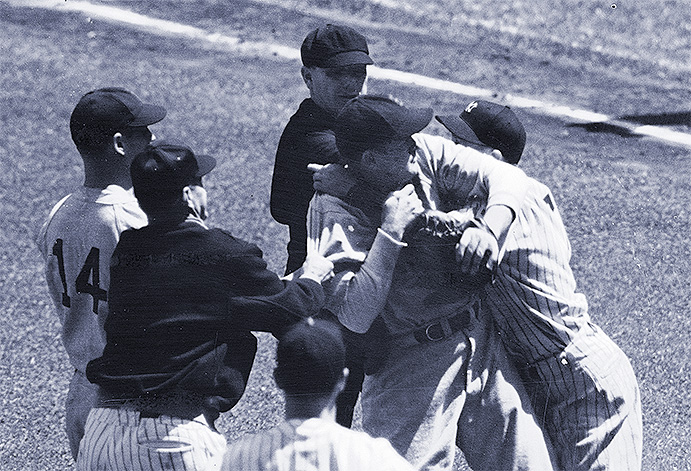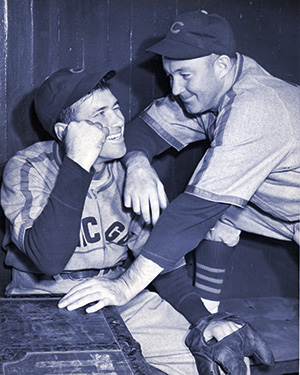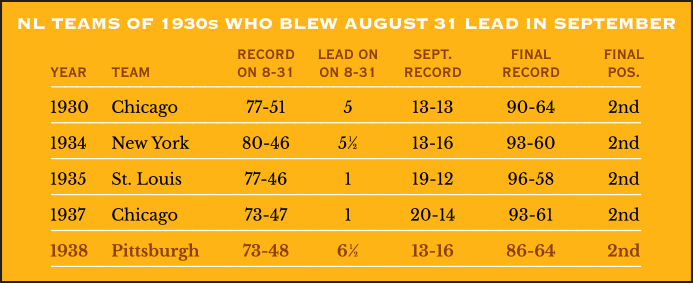THE YEARLY READER
1938: A Rockier Road
Despite winning the World Series once more, the New York Yankees endure through several adverse situations; the Chicago Cubs win the National League pennant on Gabby Hartnett’s memorable “Homer in the Gloamin’”.

New York’s Jake Powell tangles with Boston Red Sox manager-shortstop Joe Cronin in just one of many unhappy episodes endured by the Yankees as they attempted to take home their third straight American League pennant. (Associated Press)
Winners of two straight World Series and hands-down favorites to reign supreme once again in 1938, the New York Yankees were all but ready to phone in the regular season.
They may have dialed in, but there was a lot of static on the line—mostly from within their own ranks.
If anything, the Yankees looked improved for 1938, filling in what little weak spots existed on their roster. Promising second-year outfielder Tommy Henrich took over full-time, while highly regarded rookie Joe Gordon replaced an aging Tony Lazzeri at second base. The rest of the roster was in prime time, with everyone nearing or at the height of their game. Lou Gehrig, at 35 years of age, was the Yankees’ oldest player.
Everything was in place in New York for the start of the season. Everything, except for the presence of one Joe DiMaggio.
Still a young star at 23, DiMaggio had nevertheless long established his place as a terror upon opposing pitchers, batting .335 with 75 home runs and 292 runs batted in over his first two years. Paid $8,500 as a rookie, DiMaggio’s salary doubled in his second year; for 1938, he wanted it tripled to $45,000, a figure that would make him the highest-paid major leaguer.
When Yankees owner Jacob Ruppert informed DiMaggio that Lou Gehrig never made that much money, DiMaggio quipped that it was too bad Gehrig was underpaid. Nevertheless, Ruppert said no to DiMaggio’s demand and offered $25,000 instead. DiMaggio also said no, and the battle was on.
DiMaggio sat out spring training and threatened to miss regular season action as long as the dispute remained unresolved. To kill the time, he frequently appeared in public with friend and boxing promoter Joe Gould, infuriating the Yankees; they felt Gould might be acting as an advisor to DiMaggio on the order of a player agent. DiMaggio in turn became irritated when, after believing both sides had agreed to a self-imposed gag order on negotiations, Ruppert went out anyway and spun his spin to the papers.
In a country staggered by depression for nearly a decade, a holdout by any baseball player—even someone as deified as Joe DiMaggio—risked becoming unpopular with the public. The Yankees didn’t need the support of their fans; they were empowered enough by the reserve clause. $25,000 was their first and last offer, and DiMaggio could either take it or never play again.
Faced with the negatives, DiMaggio caved in. He signed for the $25,000.
The return of Joltin’ Joe to the baseball field—13 games into the regular season—was jolting. He was stunned to find fans booing him both home and away for what they perceived to be a selfish case of youthful greed. The welcome from his own teammates was just as jarring; in DiMaggio’s first game back, he collided with Joe Gordon as the two pursued a pop fly behind second base, knocking both players unconscious.
Though DiMaggio would go on to lead his team in batting average, triples, home runs and RBIs, the booing continued before the fans eventually forgave and forgot, as DiMaggio repaired his majestic stature in baseball; but in a year where Joltin’ Joe had almost left and gone away, a nation burned its angry eyes upon him.
Going nose-to-nose with Joe DiMaggio was a tolerable assignment, since he was a superstar of the highest regard. That the Yankees put up with benchwarmer Jake Powell was a bit more puzzling.
A player who showed considerable promise over his first couple big league seasons in Washington, Powell was traded to the Yankees in 1936, where his playing time and performance began to decline in short order. A drop in attitude followed, and Powell shrunk into something of a problem child.
When the Yankees treated a crowd of 81,841, one of their largest gatherings ever, by sweeping a May doubleheader from the Red Sox, Powell spoiled the day when he engaged in an ugly fight with Boston shortstop Joe Cronin after pitcher Archie McCain nailed Powell in the stomach. The public display of fisticuffs turned private when the two later reconvened under the stands. Powell was docked with a small fine and suspended three days by the American League office.
Then came a radio interview at the end of July. Queried before a game by Chicago radio station WGN, Powell joked that he kept himself in shape as an offseason policeman in Dayton, Ohio by “cracking niggers over the head.” Powell may have found it funny, but WGN obviously did not; they immediately cut the transmission and issued an apology, stating that Powell’s remarks did not reflect those of the radio station.
Though he later denied making the comments, the evidence was clear. The remark caused a huge stir, particularly within Chicago’s black community. Powell was suspended for 10 games by commissioner Kenesaw Mountain Landis—who, ironically, may have indirectly fueled Powell’s cultural incorrectness with his persistence in keeping African-Americans out of the majors.
Legend has it that Powell made the ultimate contrition for his on-air racism. He walked into Harlem one night, stepped into every bar and apologized to those present, offering to buy them drinks.
BTW: Yankees owner Jacob Ruppert lent Powell wobbly support after the radio incident, saying the remark was an unintended slip of the tongue—and publicly stated that his “colored servants” agreed…Powell’s post-baseball years would be no less bizarre—and more tragic. In 1948, after being arrested in New York for using fraudulent checks, Powell grabbed a gun at the police station—and shot himself to death.
With Powell serving his suspension, the Yankees were finally able to focus on the pennant race and quickly ended it by pulling away from second-place Cleveland. By the time they clinched their third straight AL flag in early September, the Yankees led by a full 15 games, before wallowing in lame-duck status to an eight-game finish over Boston, who rampaged past the Indians for second.
The Red Sox might have had a better shot at the Yankees had they allowed a cocky 19-year-old outfielder from San Diego to bypass the minors and come straight to Fenway—a player who, after being labeled a “busher” by the veterans at training camp, pledged to them he’d be soon making more money than the rest of them put together. As it was, Ted Williams produced more hints of things to come by destroying International League pitching for the Minneapolis Millers—batting .366 with 43 home runs and 142 RBIs.
While the Yankees took a much-deserved breather from internal peril and coasted into the World Series, the National League race went down to the wire, climaxed by the greatest home run almost never seen.
The Pittsburgh Pirates had looked sharp all year but stood on dangerous ground: First place in early September. The NL of the 1930s was fast proving that the team going into the final month with the momentum, not the lead, was likely World Series-bound. Just ask the Chicago Cubs of 1930 and 1937, the New York Giants of 1934 and the St. Louis Cardinals of 1935—all in possession of the top spot on Labor Day by more-than-scant margins, only to lose it at season’s end.
The Pirates, tanked up with the league’s best hitting led by veterans Paul Waner and Arky Vaughan, were a full seven games up to start September; but they, too, would be destined to join the long list of bubble-busting, would-be league champions.
Fast closing in on the Pirates’ tails were the Cubs, pennant winners three years before and competitive since, their younger players improving with age. The Cubs had made only one major roster change before the year, acquiring pitcher Dizzy Dean from the Cardinals. The move was considered window dressing; while Dean all but blew out his arm coming back too soon from a toe injury in 1937, he was still a big enough gate attraction that when he did pitch, the fans would follow.

Used sparingly but efficiently, sore-armed Chicago pitcher Dizzy Dean (left) is congratulated by catcher Gabby Hartnett, who took over the Cubs’ managerial reins midway through 1938 and forged a comeback pennant— thanks in part to his famous “Homer in the Gloamin’” at season’s end. (The Rucker Archive)
The Cubs won, won again, and kept winning, until they had pared the Pittsburgh seven-game lead to a game and a half—just in time for the Pirates to arrive at Chicago for a crucial three-game series to open the season’s final week.
For the first game, fragile Dizzy Dean was called upon to start his first game in a month. His fastball long gone and aching through every delivery on pure guts and smarts, Dean mastered the hard-hitting Pirates, 2-1, falling a mere out short of a complete game. He would go on to call it the greatest outing of his career.
With a mid-afternoon start for the second game, the two teams battled to a 5-5 tie after eight innings as darkness quickly descended upon unlit Wrigley Field. Umpire Jocko Conlan thought of calling the game at that point, and under normal circumstances he might have—but it would have canceled out the game’s results. The NL pennant was on the line; he let them play.
After Pittsburgh was held scoreless in the top of the ninth, the Cubs faced off against Pirates pitcher Mace Brown, whose 15 wins—all earned in relief—led the team. After getting the first two batters out, Hartnett came to the plate. Brown cornered the Cubs catcher-manager into a two-strike count, but then threw one slider too many; Hartnett launched a line drive into the darkening sky toward left field, barely clearing the ivy-strewn wall and bouncing back out onto the field. It had become so dark, the Chicago bench had to take the umpire’s word for it when he signaled a home run.
Hartnett’s home run would be forever known as “The Homer in the Gloamin”’, and it not only put Chicago into first place, it tore the Pirates’ morale into tatters as they were trashed the next day by the Cubs, 10-1, completing Chicago’s three-game sweep. The Cubs walked from there to the NL pennant.
Don’t Sleep On September
The Pirates’ collapse down the stretch continued a National League trend throughout the 1930s of teams finishing August with a hold on first place—and losing it a month later, at season’s end.

League-leading pitching lifted the Cubs, making up for an offense that was nothing special. Right-hander Bill Lee, a stalwart in Chicago throughout the 1930s, had his best year—winning 22 games and the NL earned run average title with a 2.66 mark. Clay Bryant, on the other hand, was a one-year wonder who compiled a 19-11 record and a fine 3.10 ERA for the Cubs.
Dizzy Dean started just 10 games for the Cubs and appeared in three others as a reliever, but he was still worth every bit of the $185,000 and three players the Cubs gave up to get him. Dean won seven of eight decisions and recorded a robust 1.81 ERA. His childish tantrums of previous years behind him, Dean’s value as a clubhouse leader also boosted the Cubs’ resolve throughout the year.
The celebration in Chicago ended at the World Series—as it had the two previous years with the New York Giants—when the Cubs ran into a wall called the New York Yankees.
Once again, the Yankees’ pitching staff rose to the occasion for the Fall Classic, limiting the Cubs to nine runs and a .243 average in a four-game sweep. Red Ruffing started, finished and won the first and last games of the series; in between, Lefty Gomez and Monte Pearson won their lone starts.
The closest the Cubs got to anything victorious came courtesy of Dizzy Dean in Game Two. With 42,000 screaming behind him at Wrigley, Dean had a 3-2 lead after three innings and held the Yankees at bay until the eighth—when Frankie Crosetti drilled a two-run blast over the fence to put New York in front. A two-run DiMaggio shot in the ninth ended Dean’s day, and the Cubs could not counter.
BTW: Typecast in the history books as a loyal yet light-hitting Yankee, Crosetti powered up in the World Series with four hits—two doubles, a triple and a home run.
By sweeping aside the Cubs and becoming the first AL team to win three straight World Series, the Yankees yet again reaffirmed their status as kings of the baseball world, in spite of their domestic problems.
Adversity was behind; tragedy lay ahead.
 Forward to 1939: Farewell, Iron Horse His game rapidly deteriorating, Lou Gehrig pulls himself out of the lineup—never to play again.
Forward to 1939: Farewell, Iron Horse His game rapidly deteriorating, Lou Gehrig pulls himself out of the lineup—never to play again.
 Back to 1937: Just Push Press for Repeat The New York Yankees easily repeat as world champions behind the “push-button” piloting of manager Joe McCarthy.
Back to 1937: Just Push Press for Repeat The New York Yankees easily repeat as world champions behind the “push-button” piloting of manager Joe McCarthy.
 1938 Leaders & Honors Our list of baseball’s top 10 hitters and pitchers in both the American League and National League for the 1938 baseball season, as well as the awards and honors given to the game’s top achievers of the year.
1938 Leaders & Honors Our list of baseball’s top 10 hitters and pitchers in both the American League and National League for the 1938 baseball season, as well as the awards and honors given to the game’s top achievers of the year.
 The 1930s: Dog Days of the Depression The majors take a hit from the Great Depression as both attendance and bravado are on the wane—until newborn icons Joe DiMaggio and Ted Williams emerge to rejuvenate the game’s passion for the fans.
The 1930s: Dog Days of the Depression The majors take a hit from the Great Depression as both attendance and bravado are on the wane—until newborn icons Joe DiMaggio and Ted Williams emerge to rejuvenate the game’s passion for the fans.


 Lester Rodney, former writer for “The Daily Worker,” talks about his lobbying efforts toward baseball to integrate.
Lester Rodney, former writer for “The Daily Worker,” talks about his lobbying efforts toward baseball to integrate.

